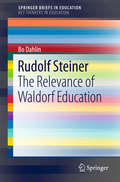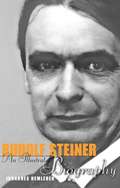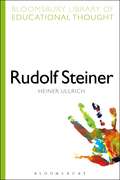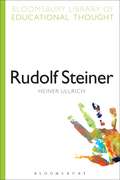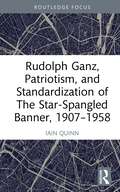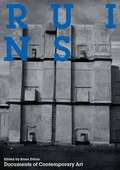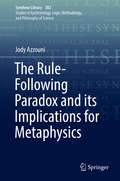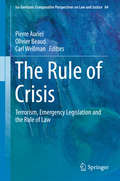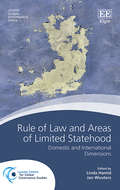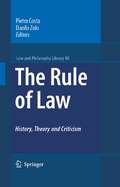- Table View
- List View
Rudolf Steiner: The Relevance of Waldorf Education (SpringerBriefs in Education)
by Bo DahlinThis book covers Rudolf Steiner’s biography, presented from an educational point of view and also unfolds the different aspects of Steiner’s educational thought in Waldorf Education. His point of view is unique in that it relates education to a wide horizon of different contexts, such as social, pedagogical, evolutionary and spiritual aspects. His ideas are philosophical (ethical, epistemological, ontological). However, above all, they are based on spiritual understanding of the human being and the world.In many ways, they stand in stark contrast to the views that inform present mainstream educational thought and practice. Nevertheless, there are points where Steiner’s ideas can find a resonance in more recent educational thought. Steiner was in many ways ahead of his time and his educational ideas are still relevant to many present day educational issues and problems.
Rudolf Steiner: An Illustrated Biography
by Johannes HemlebenRudolf Steiner's legacy is remarkable. Around the world, thousands of initiatives have been built up around his inspiration and thought, including Steiner Waldorf schools, special education establishments, medical clinics, biodynamic farms, cultural centres, and much more. At the core of this outer work stands the scientific and spiritual path which Steiner called anthroposophy - a philosophy and method which he expounded and developed throughout his life. Hemleben's concise yet informative biography throws a clear light on Steiner's life and his numerous struggles and achievements. Beginning with Steiner's childhood, Hemleben guides us through his youthful years as a respected Goethean scholar and philosopher in Weimar; his work in the Theosophical Society and the later establishing of the Anthroposophical Society; the development of anthroposophy as a spiritual science; the creation of spiritual initiatives in art, the social sciences, education, medicine, agriculture, religion and architecture; the important Christmas Foundation Conference, and his eventual death in 1925. Hemleben's biography - seen by many as the finest account of Steiner's life and work - includes a chronology, personal tributes, an extensive section for further reading, as well as an index. It is also profusely illustrated, with 69 pictures and photographs.
Rudolf Steiner: Leben Und Lehre (Bloomsbury Library of Educational Thought)
by Heiner UllrichRudolf Steiner is one of the most controversially judged educational reformers of the twentieth century. Although he received little recognition within his field, his educational thought has had a sustained and profound influence, not only in the development of the Waldorf Schools, but also in healing, socially therapeutic work, psychosomatic medicine, biological-dynamic agriculture, corporate organisation, fine arts, and architecture. Heiner Ullrich paints a concise and well-grounded portrait of the creator of the anthroposophic doctrine and Waldorf pedagogy. The text describes a wide arc from the intellectual biography of Rudolf Steiner, across his basic ideas on human development and education, to include discussion of the organisation, curriculum, methods and success of the Waldorf Schools.
Rudolf Steiner (Continuum Library of Educational Thought)
by Heiner Ullrich Richard BaileyRudolf Steiner is one of the most controversially judged educational reformers of the twentieth century. Although he received little recognition within his field, his educational thought has had a sustained and profound influence, not only in the development of the Waldorf Schools, but also in healing, socially therapeutic work, psychosomatic medicine, biological-dynamic agriculture, corporate organisation, fine arts, and architecture. Heiner Ullrich paints a concise and well-grounded portrait of the creator of the anthroposophic doctrine and Waldorf pedagogy. The text describes a wide arc from the intellectual biography of Rudolf Steiner, across his basic ideas on human development and education, to include discussion of the organisation, curriculum, methods and success of the Waldorf Schools.
Rudolf Steiner Speaks to the British: Lectures and Addresses in England and Wales
by Rudolf SteinerAs demonstrated by the contents of this book, Rudolf Steiner was able to speak to the British in a very direct and lively way. He did not need to give a long introductory build-up to his main theme, as was expected of him in Germany for instance, but could refer immediately to esoteric ideas. The intention of this volume is to give a fuller picture of Rudolf Steiner's work in Britain, and his approach to esoteric ideas while on British soil. Although the major lecture series he gave in Britain have been previously published, this book gathers together various lectures, addresses, question-and-answer sessions, minutes of important meetings and articles - a good deal of which has been unavailable in English until now. It also features a complete list of all the lectures and addresses Steiner gave in Britain, making it a valuable reference book for students of Rudolf Steiner's work.
Rudolf Virchow und Gustav Adolph Spiess: Cellular-Pathologie versus Humoral- und Solidarpathologie (Klassische Texte der Wissenschaft)
by Wolfgang U. EckartWolfgang U. Eckart kommentiert aus heutiger Sicht die beiden in die Medizingeschichte eingegangenen Arbeiten "Cellular-Pathologie" (1855) im Archiv für pathologische Anatomie und Physiologie von Rudolf Virchow und „Die Cellular-Pathologie im Gegensatz zur Humoral- und Solidarpathologie“ von Gustav Adolph Spieß, erschienen im gleichen Band des Archivs für pathologische Anatomie und Physiologie.Rudolf Virchow gilt als Gründer der modernen Pathologie. Er entwickelte die Zellularpathologie. Die bahnbrechende Erstveröffentlichung war der Aufsatz "Cellular-Pathologie". Mit dem Werk wird ein neues, mikroskopisch-lokalistisch orientiertes Paradigma in Pathologie und allgemeiner Medizin eingeleitet, das bis heute - wenngleich erweitert - die medizinische Forschung, Diagnostik und Therapie bestimmt. Virchows Gegenspieler Gustav Adolph Spieß publizierte im Anschluss die Polemik „Die Cellular-Pathologie im Gegensatz zur Humoral- und Solidarpathologie“.
Rudolph Ganz, Patriotism, and Standardization of The Star-Spangled Banner, 1907-1958
by Iain QuinnThis book examines the succession of events toward the potential standardization of the music for “The Star-Spangled Banner” from an initial letter to President Roosevelt in 1907 to the 1958 congressional hearings on the National Anthem, and the later work of the Swiss-Born American pianist, Rudolph Ganz. These events took place across five decades when a culture of public patriotism was especially pronounced for immigrant musicians. This book contextualizes the complementary experiences of a leading immigrant musician, Ganz, who successfully navigated the world of public patriotism while pursuing the realization of a standardized version. The materials are discussed through the lens of the performance practice. The legacy of standardization has not previously been examined. The response and actions of an immigrant, Ganz, in a culture of necessary patriotism for foreign-born artists shed important new light on this topic. It demonstrates the challenges, fears, and cultural expectations regarding the standardization of an important patriotic work.
Rudolph Ganz, Patriotism, and Standardization of The Star-Spangled Banner, 1907-1958
by Iain QuinnThis book examines the succession of events toward the potential standardization of the music for “The Star-Spangled Banner” from an initial letter to President Roosevelt in 1907 to the 1958 congressional hearings on the National Anthem, and the later work of the Swiss-Born American pianist, Rudolph Ganz. These events took place across five decades when a culture of public patriotism was especially pronounced for immigrant musicians. This book contextualizes the complementary experiences of a leading immigrant musician, Ganz, who successfully navigated the world of public patriotism while pursuing the realization of a standardized version. The materials are discussed through the lens of the performance practice. The legacy of standardization has not previously been examined. The response and actions of an immigrant, Ganz, in a culture of necessary patriotism for foreign-born artists shed important new light on this topic. It demonstrates the challenges, fears, and cultural expectations regarding the standardization of an important patriotic work.
Ruggiero Boscovich’s Theory of Natural Philosophy: Points, Distances, Determinations (Science Networks. Historical Studies #60)
by Luca GuzzardiDrawing on published works, correspondence and manuscripts, this book offers the most comprehensive reconstruction of Boscovich’s theory within its historical context. It explains the genesis and theoretical as well as epistemological underpinnings in light of the Jesuit tradition to which Boscovich belonged, and contrasts his ideas with those of Newton, Leibniz, and their legacy. Finally, it debates crucial issues in early-modern physical science such as the concept of force, the particle-like structure of matter, the idea of material points and the notion of continuity, and shares novel insights on Boscovich’s alleged influence on later developments in physics. With its attempt to reduce all natural forces to one single law, Boscovich’s Theory of Natural Philosophy, published in 1758, left a lasting impression on scientists and philosophers of every age regarding the fundamental unity of physical phenomena. The theory argues that every pair of material points is subject to one mutual force — and always the same force — which is their propensity to be mutually attracted or repelled, depending on their distance from one another. Furthermore, the action of this unique force is visualized through a famous diagram that fascinated generations of scientists. But his understanding of key terms of the theory — such as the notion of force involved and the very idea of a material point — is only ostensibly similar to our current conceptual framework. Indeed, it needs to be clarified within the plurality of contexts in which it has emerged rather than being considered in view of later developments.The book is recommended for scholars and students interested in the ideas of the early modern period, especially historians and philosophers of science, mathematicians and physicists with an interest in the history of the discipline, and experts on Jesuit science and philosophy.
Ruinen-Ästhetik: Über die Spuren der Zeit im Raum der Gegenwart (Edition Moderne Postmoderne)
by Kevin BückingDie Ästhetik der Ruinen kennzeichnet eine Lust am Paradoxen. Zwischen Natur und Kultur, Erbauung und Zerstörung, Melancholie und Hoffnung, Vergangenheit und Zukunft erscheinen die Ruinen als Spuren der Zeit im Raum der Gegenwart ihrer ästhetischen Begegnung. Kevin Bücking zeigt, inwiefern die Ästhetik der Ruinen und des Ruinösen in einem besonderen Zusammenspiel aus leiblich-sinnlichen Erfahrungen und begrifflichen Reflexionen besteht. In Auseinandersetzung mit unterschiedlichen ästhetischen Medien wie Malerei, Fotografie, Film, Computerspiel und Virtual Reality wird ersichtlich: Die Faszination an Ruinen und Ruinösem ist als ein atmosphärisches Reflexionsgeschehen zu verstehen.
Ruins: Documents Of Contemporary Art (Documents Of Contemporary Art Ser. (PDF)
by Brian DillonThe "ruins" of the modern era are the landmarks of recent art’s turn toward site and situation, history and memory. The abiding interest of artists in ruination and decay has led in particular to the concept of the modern ruin – an ambiguous site of artistic and architectural modernism, personal and collective memories, and the cultural afterlife of eras such as those of state communism and colonialism. Contemporary art’s explorations of the ruin can evoke on the one hand diverse experiences of nostalgia and on the other a ceaselessly renewed encounter with catastrophes of the recent past and apprehensions of the future. For every relic of a harmonious era or utopian dream stands another recalling industrial decline, environmental disaster, and the depredations of war.
Rule Breaking and Political Imagination
by Kenneth A. Shepsle“Imagination may be thought of as a ‘work-around.’ It is a resourceful tactic to ‘undo’ a rule by creating a path around it without necessarily defying it. . . . Transgression, on the other hand, is rule breaking. There is no pretense of reinterpretation; it is defiance pure and simple. Whether imagination or disobedience is the source, constraints need not constrain, ties need not bind.” So writes Kenneth A. Shepsle in his introduction to Rule Breaking and Political Imagination. Institutions are thought to channel the choices of individual actors. But what about when they do not? Throughout history, leaders and politicians have used imagination and transgression to break with constraints upon their agency. Shepsle ranges from ancient Rome to the United States Senate, and from Lyndon B. Johnson to the British House of Commons. He also explores rule breaking in less formal contexts, such as vigilantism in the Old West and the CIA’s actions in the wake of 9/11. Entertaining and thought-provoking, Rule Breaking and Political Imagination will prompt a reassessment of the nature of institutions and remind us of the critical role of political mavericks.
Rule Breaking and Political Imagination
by Kenneth A. Shepsle“Imagination may be thought of as a ‘work-around.’ It is a resourceful tactic to ‘undo’ a rule by creating a path around it without necessarily defying it. . . . Transgression, on the other hand, is rule breaking. There is no pretense of reinterpretation; it is defiance pure and simple. Whether imagination or disobedience is the source, constraints need not constrain, ties need not bind.” So writes Kenneth A. Shepsle in his introduction to Rule Breaking and Political Imagination. Institutions are thought to channel the choices of individual actors. But what about when they do not? Throughout history, leaders and politicians have used imagination and transgression to break with constraints upon their agency. Shepsle ranges from ancient Rome to the United States Senate, and from Lyndon B. Johnson to the British House of Commons. He also explores rule breaking in less formal contexts, such as vigilantism in the Old West and the CIA’s actions in the wake of 9/11. Entertaining and thought-provoking, Rule Breaking and Political Imagination will prompt a reassessment of the nature of institutions and remind us of the critical role of political mavericks.
Rule Breaking and Political Imagination
by Kenneth A. Shepsle“Imagination may be thought of as a ‘work-around.’ It is a resourceful tactic to ‘undo’ a rule by creating a path around it without necessarily defying it. . . . Transgression, on the other hand, is rule breaking. There is no pretense of reinterpretation; it is defiance pure and simple. Whether imagination or disobedience is the source, constraints need not constrain, ties need not bind.” So writes Kenneth A. Shepsle in his introduction to Rule Breaking and Political Imagination. Institutions are thought to channel the choices of individual actors. But what about when they do not? Throughout history, leaders and politicians have used imagination and transgression to break with constraints upon their agency. Shepsle ranges from ancient Rome to the United States Senate, and from Lyndon B. Johnson to the British House of Commons. He also explores rule breaking in less formal contexts, such as vigilantism in the Old West and the CIA’s actions in the wake of 9/11. Entertaining and thought-provoking, Rule Breaking and Political Imagination will prompt a reassessment of the nature of institutions and remind us of the critical role of political mavericks.
Rule Breaking and Political Imagination
by Kenneth A. Shepsle“Imagination may be thought of as a ‘work-around.’ It is a resourceful tactic to ‘undo’ a rule by creating a path around it without necessarily defying it. . . . Transgression, on the other hand, is rule breaking. There is no pretense of reinterpretation; it is defiance pure and simple. Whether imagination or disobedience is the source, constraints need not constrain, ties need not bind.” So writes Kenneth A. Shepsle in his introduction to Rule Breaking and Political Imagination. Institutions are thought to channel the choices of individual actors. But what about when they do not? Throughout history, leaders and politicians have used imagination and transgression to break with constraints upon their agency. Shepsle ranges from ancient Rome to the United States Senate, and from Lyndon B. Johnson to the British House of Commons. He also explores rule breaking in less formal contexts, such as vigilantism in the Old West and the CIA’s actions in the wake of 9/11. Entertaining and thought-provoking, Rule Breaking and Political Imagination will prompt a reassessment of the nature of institutions and remind us of the critical role of political mavericks.
Rule Breaking and Political Imagination
by Kenneth A. Shepsle“Imagination may be thought of as a ‘work-around.’ It is a resourceful tactic to ‘undo’ a rule by creating a path around it without necessarily defying it. . . . Transgression, on the other hand, is rule breaking. There is no pretense of reinterpretation; it is defiance pure and simple. Whether imagination or disobedience is the source, constraints need not constrain, ties need not bind.” So writes Kenneth A. Shepsle in his introduction to Rule Breaking and Political Imagination. Institutions are thought to channel the choices of individual actors. But what about when they do not? Throughout history, leaders and politicians have used imagination and transgression to break with constraints upon their agency. Shepsle ranges from ancient Rome to the United States Senate, and from Lyndon B. Johnson to the British House of Commons. He also explores rule breaking in less formal contexts, such as vigilantism in the Old West and the CIA’s actions in the wake of 9/11. Entertaining and thought-provoking, Rule Breaking and Political Imagination will prompt a reassessment of the nature of institutions and remind us of the critical role of political mavericks.
Rule Breaking and Political Imagination
by Kenneth A. Shepsle“Imagination may be thought of as a ‘work-around.’ It is a resourceful tactic to ‘undo’ a rule by creating a path around it without necessarily defying it. . . . Transgression, on the other hand, is rule breaking. There is no pretense of reinterpretation; it is defiance pure and simple. Whether imagination or disobedience is the source, constraints need not constrain, ties need not bind.” So writes Kenneth A. Shepsle in his introduction to Rule Breaking and Political Imagination. Institutions are thought to channel the choices of individual actors. But what about when they do not? Throughout history, leaders and politicians have used imagination and transgression to break with constraints upon their agency. Shepsle ranges from ancient Rome to the United States Senate, and from Lyndon B. Johnson to the British House of Commons. He also explores rule breaking in less formal contexts, such as vigilantism in the Old West and the CIA’s actions in the wake of 9/11. Entertaining and thought-provoking, Rule Breaking and Political Imagination will prompt a reassessment of the nature of institutions and remind us of the critical role of political mavericks.
Rule-following and Meaning
by Alexander Miller Crispin WrightThe rule-following debate, in its concern with the metaphysics and epistemology of linguistic meaning and mental content, goes to the heart of the most fundamental questions of contemporary philosophy of mind and language. This volume gathers together the most important contributions to the topic, including papers by Simon Blackburn, Paul Boghossian, Graeme Forbes, Warren Goldfarb, Paul Horwich, John McDowell, Colin McGinn, Ruth Millikan, Philip Pettit, George Wilson, Crispin Wright, and Jose Zalabardo. The debate has centred on Saul Kripke's reading of the rule-following sections in Wittgenstein and his consequent posing of a sceptical paradox that threatens our everyday notions of linguistic meaning and mental content. These essays are attempts to respond to this challenge and represent some of the most important work in contemporary theory of meaning. With an introductory essay and a comprehensive guide to further reading this book is an excellent resource for courses in philosophy of mind, philosophy of language, Wittgenstein, and metaphysics, as well as for all philosophers, linguists, and cognitive scientists with interests in these areas.
Rule-following and Meaning
by Alexander Miller Crispin WrightThe rule-following debate, in its concern with the metaphysics and epistemology of linguistic meaning and mental content, goes to the heart of the most fundamental questions of contemporary philosophy of mind and language. This volume gathers together the most important contributions to the topic, including papers by Simon Blackburn, Paul Boghossian, Graeme Forbes, Warren Goldfarb, Paul Horwich, John McDowell, Colin McGinn, Ruth Millikan, Philip Pettit, George Wilson, Crispin Wright, and Jose Zalabardo. The debate has centred on Saul Kripke's reading of the rule-following sections in Wittgenstein and his consequent posing of a sceptical paradox that threatens our everyday notions of linguistic meaning and mental content. These essays are attempts to respond to this challenge and represent some of the most important work in contemporary theory of meaning. With an introductory essay and a comprehensive guide to further reading this book is an excellent resource for courses in philosophy of mind, philosophy of language, Wittgenstein, and metaphysics, as well as for all philosophers, linguists, and cognitive scientists with interests in these areas.
The Rule-Following Paradox and its Implications for Metaphysics (Synthese Library #382)
by Jody AzzouniThis monograph presents Azzouni’s new approach to the rule-following paradox. His solution leaves intact an isolated individual’s capacity to follow rules, and it simultaneously avoids replacing the truth conditions for meaning-talk with mere assertability conditions for that talk. Kripke’s influential version of Wittgenstein’s rule-following paradox—and Wittgenstein’s views more generally—on the contrary, make rule-following practices and assertions about those practices subject to community norms without which they lose their cogency. Azzouni summarizes and develops Kripke’s original version of Wittgenstein’s rule-following paradox to make salient the linchpin assumptions of the paradox. By doing so, Azzouni reveals how compelling Kripke’s earlier work on the paradox was. Objections raised over the years by Fodor, Forbes Ginsborg, Goldfarb, Tait, Wright, and many others, are all shown to fail. No straight solution (a solution that denies an assumption of the paradox) can be made to work. Azzouni illustrates this in detail by showing that a popular family of straight solutions due to Lewis and refined by Williams, “reference magnetism,” fail as well. And yet an overlooked sceptical solution is still available in logical space. Azzouni describes a series of “disposition-meaning” private languages that he shows can be successfully used by a population of speakers to communicate with one another despite their ideolectical character. The same sorts of languages enable solitary “Robinson Crusoes” to survive and flourish in their island habitats. These languages—sufficiently refined—have the same properties normal human languages have; and this is the key to solving the rule-following paradox without sacrificing the individual’s authority over her self-imposed rules or her ability to follow those rules. Azzouni concludes this unusual monograph by uncovering a striking resemblance between the rule-following paradox and Hume’s problem of induction: he shows the rule-following paradox to be a corollary of Hume’s problem that arises when the problem of induction is applied to an individual’s own abilities to follow rules.“The book is clearly and engagingly written, and the conclusions are well-argued-for. (Depressingly well-argued-for in the case of Chapter 3, as I've always been partial to Lewisian responses to Putnam's model-theoretic argument--I'm rethinking that now.) And the proposed solution to the rule-following paradox really is novel.” Joshua Brown - Gustavus Adolphus College
The Rule of Crisis: Terrorism, Emergency Legislation and the Rule of Law (Ius Gentium: Comparative Perspectives on Law and Justice #64)
by Pierre Auriel Olivier Beaud Carl WellmanThis book analyzes emergency legislations formed in response to terrorism. In recognition that different countries, with different legal traditions, have different solutions, it adopts a comparative point of view. The countries profiled include America, France, Israel, Poland, Germany and United Kingdom. The goal is not to offer judgment on one response or the other. Rather, the contributors offer a comprehensive and thoughtful examination of the entire concept. In the process, they draw attention to the inadaptability of traditional legal and philosophical categories in a new and changing political world. The contributors first criticize the idea of these legislations. They then go on to develop different models to respond to these crises. They build a general analytical framework by answering such questions as: What is an emergency legislation? What kinds of emergencies justify laws of this nature? Why is contemporary terrorism such a specific emergency justifying new laws? Using legal and philosophical reflections, this study looks at how we are changing society. Coverage also provides historical experiences of emergency legislations to further illustrate this point. In the end, readers will gain insight into the long-term consequences of these legislations and how they modify the very work of the rule of law.
The Rule of Law: Definitions, Measures, Patterns and Causes
by J. Møller S. SkaaningThrough critical analysis of key concepts and measures of the rule of law, this book shows that the choice of definitions and measures affects descriptive and explanatory findings about nomocracy. It argues a constitutionalist legacy from centuries ago explains why European civilizations display higher adherence to rule of law than other countries.
Rule of Law and Areas of Limited Statehood: Domestic and International Dimensions (Leuven Global Governance series)
This thought-provoking book addresses the legal questions raised by the nexus between the rule of law and areas of limited statehood, in which the State lacks the ability to exercise the full depth of its governmental authority. Working from an international law perspective, it examines the implications of limited statehood for the traditional State-based framing of the international legal order. Featuring original contributions written by renowned international scholars, chapters investigate key issues arising at the junction between domestic and international rule of law and areas of limited statehood, as well as the alternative modes of governance that develop therein, both with and without the approval of the State. Contributors discuss the impact of contested sovereignty on the rule of law, international responsibility with regard to rebel governance in areas of limited statehood and the consequences of limited statehood for international peace and security. This book will be useful for students and scholars of international law and international relations, particularly those working on sovereignty and statehood, non-state actors, State responsibility and the rule of law. It will also appeal to practitioners and policy-makers working in these same fields in either the State or global governance apparatus.
The Rule of Law History, Theory and Criticism (Law and Philosophy Library #80)
by E. SantoroAuthors Costa and Zolo share the conviction that a proper understanding of the rule of law today requires reference to a global problematic horizon. This book offers some relevant guides for orienting the reader through a political and legal debate where the rule of law (and the doctrine of human rights) is a concept both controversial and significant at the national and international levels.
